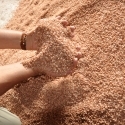08 Feb 2013
Focus on Calcium
Presented at the GRDC Advisors Update, Ballarat
 Calcium deficiency in tomato
Calcium deficiency in tomato
The roles of Calcium
Calcium (Ca) is an essential plant nutrient required by animals and plants in relatively large amounts for healthy growth. In addition to its role as one of the macronutrients in plant nutrition, sufficient Ca has a role in maintaining soil physical properties, and in reclaiming sodic soils.
Calcium contributes to soil fertility by helping maintain a soil with flocculated clays and therefore with good aeration. Soil structure and water holding capacity are improved if the amount of exchangeable sodium (ESP) is kept below 5% of the cation exchange capacity of the soil. Because Ca has a stronger affinity for the exchange sites than sodium, added Ca can improve soil structure by displacing sodium, which allows the negatively charged clay particles to aggregate. These exchange properties of different cations are a consequence of differences in size and charge density (Table 1).
Table 1. Charge and relative size of some soil cations. Ionic radius of the hydrated ion is given in picometers (10-12 m) (values vary on the source and method of measurement).
Monovalent (1+) | Divalent (2+) | Trivalent (3+) |
Sodium – 450 pm | Magnesium – 800 pm | Aluminium – 900 pm |
Potassium – 300 pm | Calcium - 600 pm | |
Rubidium – 250 pm | Strontium – 500 pm |
Soil acidity can restrict crop growth due to differences in nutrient availability, such as lower Ca and magnesium levels, and higher exchangeable aluminium levels. This is because the high concentration of hydrogen ions displaced Ca and magnesium (Mg), which can then leach on sandy soils. Calcium itself plays no other role in acidity management other than as a spectator ion in applied lime. The adjustment of soil pH is through the carbonate anion (CO32-), which is slowly released and ultimately converts the acidic hydrogen ions to water and carbon dioxide. Unusually high exchangeable Mg may pose a problem for Ca uptake by roots and can disrupt soil structure. Strongly acidic peat and muck soils tend to have low total soil calcium, while sandy soils can have Ca leached out of the root zone in high rainfall zones.
Calcium as a plant nutrient
Plants require Ca to develop strong cell walls and membranes. Conversely, insufficient Ca in plants leads to a breakdown of cell walls and membranes, and to a variety of disease and post-harvest problems particularly in fresh produce such as apples and celery. Grasses such as wheat are less susceptible to deficiency than dicots such as canola, with the latter reported to have around twice the Ca demand of wheat (Figure 1). Other high Ca demanding crops are peanuts, almonds and apples.
Figure 1. Yield response (g/pot) of canola (top lines) and wheat (bottom line) to applied csalcium in a highly acidic sand (pH 4.4, 3% clay, 0.6% organic carbon, 1.8 cmol(+)/kg) (Brennan et al. 2007, JPl.Nutr. 30:1167).
Deficiency appears as browning and the die-back of growing tips of roots and leaves. Leaves curl and margins turn brown, with newly emerging leaves sticking together at the margins leaving expanded leaves shredded at their margins. Probably the most well known symptom of Ca deficiency is blossom-end rot of tomato fruit, but this problem is closely related to plant water stress and the difficulty in delivering Ca to the fruit. Canola can also show “wither tip” or “tipple top” which is the collapse of the terminal bud under rapid growth and intermittent water supply (Figure 2). This illustrates one of the problems with Ca deficiencies—is it a lack of Ca in the soil that is the problem or is it a problem with delivery of Ca within the plant? Most often the latter.
Figure 2. Where nutrient deficiencies are seen (left) and typical symptoms in tomato (centre) and canola (right).
In soil that seems to have adequate Ca, deficiency symptoms sometime occur. The problem often appears when Ca does not adequately move to the plant organs where it is needed. Calcium is taken up behind the root tip and moves primarily in the transpiration stream up from the roots. Once in the plant, Ca is mostly present in cell walls and so is not readily remobilized from one plant part to another. Plant organs that have low transpiration (e.g. fruits such as melons, apples, and tomatoes with a waxy skin, or the inner/sheltered parts of leafy plants such as lettuce) can develop low-Ca disorders. When these disorders develop, sometimes it is related to the soil Ca supply, but it is frequently related to water stress, cool temperature, and limited transpiration.
Plant tissue testing is not a reliable diagnosis of Ca deficiency, mainly because the symptoms seen are often a transport problem, rather than a supply problem. There are few reports of critical tissue concentrations, although Reuter and Robinson (1997, Plant Analysis: An interpretation manual, CSIRO Press) indicate marginal Ca levels in canola at 0.8-1.2% in the youngest mature leaf before flowering and <0.2% for the youngest mature wheat leaf blade during mid-late tillering. Growth stage can be important, but if the sample is from the youngest tissues, this is likely to be the first indicator of reduced Ca supply.
Soil supply of calcium
Most agricultural soils contain considerable amounts of Ca. A good estimate is that each cmol of exchangeable Ca is equivalent to 400 kg/ha to a depth of 15 cm. Many soils contain several tons of exchangeable Ca on cation exchange sites. Therefore, it may take large applications of Ca to make significant changes in soil chemistry. There are soil conditions where Ca applications are very helpful. Sandy soils and crops irrigated with low Ca water may be particularly vulnerable to low Ca availability. Soils with low pH generally have low Ca availability.
Soil pH generally provides a good assessment of Ca levels in soils. Alkaline soils contain more Ca than acid soils, and even in soils where Ca is present as deposits of gypsum (calcium sulfate) or limestone (calcium carbonate), some of the Ca from these compounds will be available to the crop. This is because these minerals are in a solubility equilibrium reaction. For example, gypsum has a solubility of around 2.4 g/l and calcium carbonate has a solubility of 0.013 g/l so the amount of Ca that results from the gypsum is significantly more that the amount from the calcium carbonate. The sulfate form releases more free calcium (Ca2+) ions than the carbonate form because the Ks (solubility product) of calcium sulfate is around 10,000 times more than that for calcium carbonate (3.14x10-5 versus 4.8x10-9).
At very high soil pH (>9), calcium carbonate becomes less soluble and so Ca supply may be limited under these conditions. This can interact with intermittent drought so that low supply and poor transport can interact to give deficiency symptoms in crops with high demand.
When low Ca is causing plant problems, start with getting the soil tested. Make sure there is adequate Ca present and low pH is not a problem. Table 2 gives a good summary of the importance of levels of cations in soils. In solutions (either soil or hydroponic), the critical deficiency concentrations for exchangeable cations vary among species, but are reported in the range of 0.5 to 1.5 cmol/kg for Ca, 0.2 to 0.3 cmol/kg for Mg and 0.2 to 0.5 cmol/kg for K (Kopittke & Menzies, 2007, SSSAJ, 71:259). The solution concentrations are lower than the soil values in Table 2 because of exchange equilibria and the effect of soil water content on these cations. The use of these nutrient sufficiency levels forms evidence based values for assessing potential Ca deficiency.
Table 2. Levels of exchangeable cations (cmol(+)/kg). From Hazelton&Murphy 2007, Interpreting soil test results, CSIRO Publishing.
Sodium | Potassium | Calcium | Magnesium | |
| Very Low | <0.1 | <0.2 | <2 | <0.3 |
| Low | 0.1-0.3 | 0.2-0.3 | 2-5 | 0.3-1.0 |
| Moderate | 0.3-0.7 | 0.3-0.7 | 5-10 | 1-3 |
| High | 0.7-2.0 | 0.7-2.0 | 10-20 | 3-8 |
| Very High | >2 | >2 | >20 | >8 |
Cation interactions
Competition occurs among cations such as ammonium, K and Mg for root uptake. It is also known that very high Mg levels can adversely affect soil structural stability. Magnesium and sodium can also interfere with soil K dynamics.
The ratio of concentrations of cations in soil solution bear no relationship to the relative amounts of exchangeable cations. Although there is a widely held view that the base cation saturation ratios (BCSR) are important in defining soil health and nutrient status, the evidence shows that plant growth and yield is not impeded across a wide range of cation ratios. More important is the actual root zone concentration of these nutritionally important cations, however there are few reports of critical soil values in terms of either exchangeable calcium concentration or the calcium saturation percentage for temperate crops.
So, why do most soil test report cation ratios such as Ca:Mg ratios and various cation ratios that imply a “balanced soil”? That is a mystery to soil and crop scientists, as the science does not support an ideal base cation saturation ratio, and that emphasis should be placed on the providing adequate cations rather than adjusting soil to some “ideal” ratio.
Sources of calcium
Large additions of Ca inputs such as lime or gypsum may be recommended to address soil pH and sodicity problems. If soil pH is adjusted to above 5.5, or ESP reduced below 5%, calcium is unlikely to be in low supply. When targeted inputs are needed during the growing season, several highly soluble Ca sources are available. They may be best applied to the active root zone to promote rapid uptake.
Lime (~40% Ca) should be used on acid soils at rates to adjust the soil pH to the target level. Typical rates are 2.5 to 7.5 t/ha and a lime requirement test will assist in identifying an appropriate rate. In cropping systems, lime should be applied several months ahead of planting and mechanically incorporated. Lime will not dissolve in alkaline soils so it should not be considered as a Ca source in those situations.
Gypsum (~23% Ca) is used as a Ca supplement and as soil ameliorant. When used, surface applied gypsum needs to be applied well ahead of planting.
Phosphate fertilizers contain quite large amounts of Ca. For example, single superphosphate has ~20% Ca and triple superphosphate has ~15% Ca. There is very little Ca in MAP or DAP.
Foliar sources such as calcium nitrate (19% Ca), calcium ammonium nitrate (~10% Ca) and chelated calcium can be beneficial to address potential deficiencies, but only a limited amount of Ca can be assimilated this way. However, a foliar application near the tissue at risk (such as developing almonds or apples) can reduce the risk of the effects of Ca deficiency. There is no published evidence in Australia to show that adding Ca enhances N uptake, and it is difficult to propose a mechanism by which this might occur.
Ask for the evidence. While low Ca status can appear, it is not always an indication that yields will increase if additional Ca is supplied. For many crops (especially horticultural crops) getting Ca supply right is more about quality than yield. Ask your supplier for results from replicated, randomized and statistically analysed experiments on these products before making a judgment about using them.
Units and abbreviations:
CBSP – cation base saturation percentage – the sum of the Na, K, Mg and Ca concentrations divided by the soil CEC measured at pH 8.2.
CBSR – cation base saturation ratio. Is the ratio of the concentrations of the cations on the colloid.
ESP - exchangable sodium percentage; the percentage of the cation exchange capacity of the soil occupied by sodium ions.
Calcium saturation – the percentage of the cation exchange capacity of the soil occupied by calcium ions.
Cmol(+)/kg – centimoles of charge; can be applied to the soil cation exchange capacity (CEC), or to a particular cation concentration in the soil. The older expression for this was milliequivant of charge per 100 g, but the numbers are the same for either unit.
pH – soil acidity, which is the concentration of the hydrogen cation in solution.
Acknowledgements, The author would like to thank Dr Rengasamy (University of Adelaide) and Dr Rob Mikkelsen (International Plant Nutrition Institute, California) for their guidance with aspects of this article.




